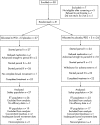Polyethylene glycol 3350 plus electrolytes for chronic constipation in children: a double blind, placebo controlled, crossover study
- PMID: 17626140
- PMCID: PMC2083581
- DOI: 10.1136/adc.2006.115493
Polyethylene glycol 3350 plus electrolytes for chronic constipation in children: a double blind, placebo controlled, crossover study
Erratum in
- Arch Dis Child. 2008 Jan;93(1):93
Abstract
Objectives: To assess the efficacy and safety of polyethylene glycol 3350 plus electrolytes (PEG+E) for the treatment of chronic constipation in children.
Design: Randomised, double blind, placebo controlled crossover trial, with two 2-week treatment periods separated by a 2-week placebo washout.
Setting: Six UK paediatric departments.
Participants: 51 children (29 girls, 22 boys) aged 24 months to 11 years with chronic constipation (lasting > or =3 months), defined as < or =2 complete bowel movements per week and one of the following: pain on defaecation on 25% of days; > or =25% of bowel movements with straining; > or =25% of bowel movements with hard/lumpy stools. 47 children completed the double blind treatment.
Main outcome measures: Number of complete defaecations per week (primary efficacy variable), total number of complete and incomplete defaecations per week, pain on defaecation, straining on defaecation, faecal incontinence, stool consistency, global assessment of treatment, adverse events and physical examination.
Results: The mean number of complete defaecations per week was significantly higher for children on PEG+E than on placebo (3.12 (SD 2.05) v 1.45 (SD 1.20), respectively; p<0.001). Further significant differences in favour of PEG+E were observed for total number of defaecations per week (p = 0.003), pain on defaecation (p = 0.041), straining on defaecation (p<0.001), stool consistency (p<0.001) and percentage of hard stools (p = 0.001). Treatment related adverse events (all mild or moderate) occurred in similar numbers of children on PEG+E (41%) and placebo during treatment (45%).
Conclusions: PEG+E is significantly more effective than placebo, and appears to be safe and well tolerated in the treatment of chronic constipation in children.
Conflict of interest statement
Competing interests: Dr Mike Geraint is an employee of Norgine Ltd. All other authors declare that they have nothing to declare.
Similar articles
-
Randomized clinical trial: macrogol/PEG 3350 plus electrolytes for treatment of patients with constipation associated with irritable bowel syndrome.Am J Gastroenterol. 2013 Sep;108(9):1508-15. doi: 10.1038/ajg.2013.197. Epub 2013 Jul 9. Am J Gastroenterol. 2013. PMID: 23835436 Clinical Trial.
-
Macrogol 3350 plus electrolytes for chronic constipation in children: a single-centre, open-label study.J Paediatr Child Health. 2007 Jul-Aug;43(7-8):527-31. doi: 10.1111/j.1440-1754.2007.01116.x. J Paediatr Child Health. 2007. PMID: 17635680
-
A comparison of polyethylene glycol laxative and placebo for relief of constipation from constipating medications.South Med J. 2007 Nov;100(11):1085-90. doi: 10.1097/SMJ.0b013e318157ec8f. South Med J. 2007. PMID: 17984738 Clinical Trial.
-
Use of low dose polyethylene glycol solutions in the treatment of functional constipation.Ital J Gastroenterol Hepatol. 1999 Nov;31 Suppl 3:S245-8. Ital J Gastroenterol Hepatol. 1999. PMID: 10726228 Review.
-
Pediatric constipation therapy using guidelines and polyethylene glycol 3350.Ann Pharmacother. 2004 Apr;38(4):686-93. doi: 10.1345/aph.1D297. Epub 2004 Feb 27. Ann Pharmacother. 2004. PMID: 14990783 Review.
Cited by
-
Multicentre Study Into the Use of Polyethylene Glycol With Electrolytes Over at Least 6 Months to Treat Constipation in Paediatric Populations.JPGN Rep. 2023 Oct 5;4(4):e353. doi: 10.1097/PG9.0000000000000353. eCollection 2023 Nov. JPGN Rep. 2023. PMID: 38034437 Free PMC article.
-
Nationwide Survey for Application of ROME IV Criteria and Clinical Practice for Functional Constipation in Children.J Korean Med Sci. 2019 Jul 8;34(26):e183. doi: 10.3346/jkms.2019.34.e183. J Korean Med Sci. 2019. PMID: 31269544 Free PMC article.
-
Clinical practice : diagnosis and treatment of functional constipation.Eur J Pediatr. 2011 Aug;170(8):955-63. doi: 10.1007/s00431-011-1515-5. Epub 2011 Jun 24. Eur J Pediatr. 2011. PMID: 21701812 Review.
-
Comparing the Effect of a Herbal-based Laxative (Goleghand®) and Polyethylene Glycol on Functional Constipation among Children: A Randomized Controlled Trial.J Res Pharm Pract. 2021 May 13;10(1):43-49. doi: 10.4103/jrpp.JRPP_20_133. eCollection 2021 Jan-Mar. J Res Pharm Pract. 2021. PMID: 34295852 Free PMC article.
-
Managing functional constipation in children.Paediatr Child Health. 2011 Dec;16(10):661-70. Paediatr Child Health. 2011. PMID: 23204909 Free PMC article.
References
-
- Candy D, Davies G, Ross R. eds. Clinical paediatrics and child health. Edinburgh: WB Saunders 2001
-
- Loening‐Baucke V. Chronic constipation in children. Gastroenterology 19931051557–1564. - PubMed
-
- Fitzgerald J F. Constipation in children. Pediatr Rev 19878299–302. - PubMed
-
- Culbert P, Gillet H, Ferguson A. Highly effective oral therapy (polyethylene glycol/electrolyte solution) for faecal impaction and severe constipation. Clin Drug Invest 199816(5)153–155.
Publication types
MeSH terms
Substances
LinkOut - more resources
Full Text Sources
Other Literature Sources
Medical

